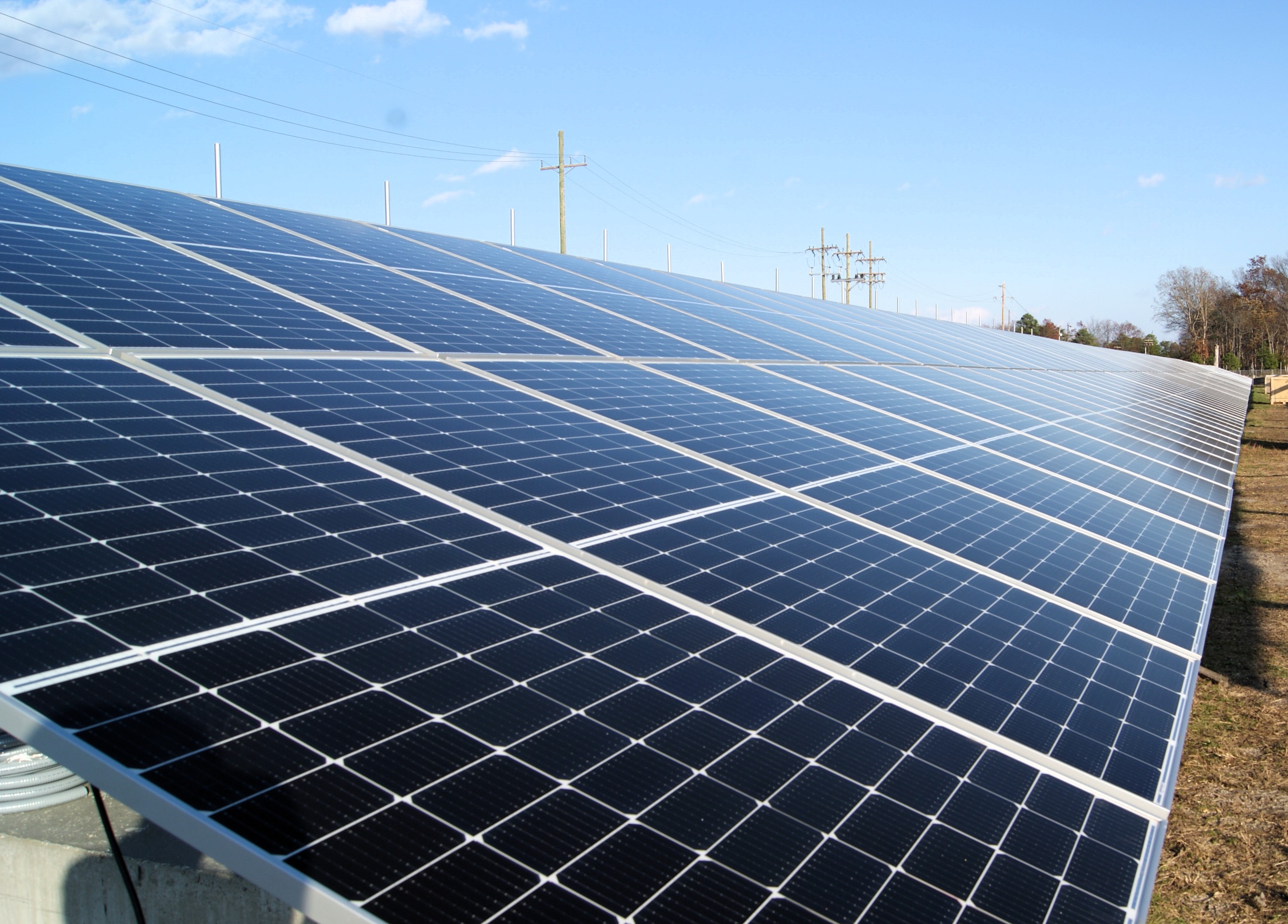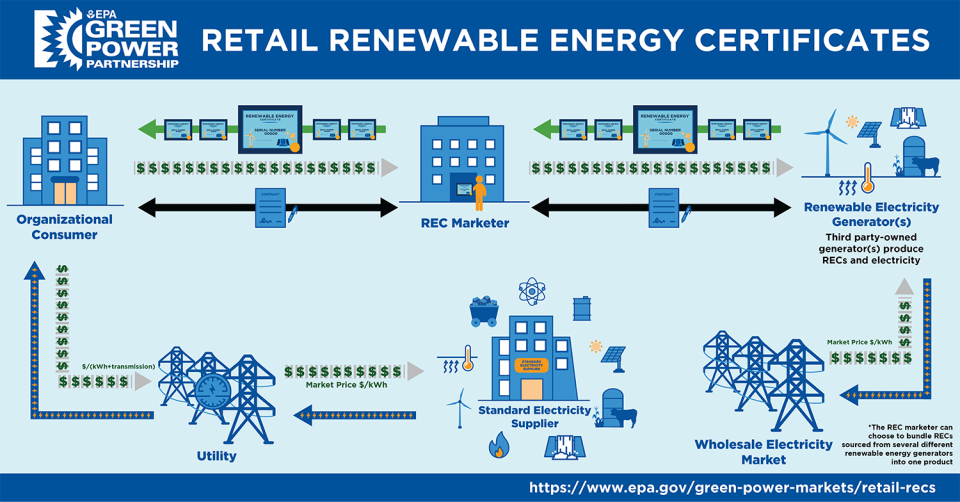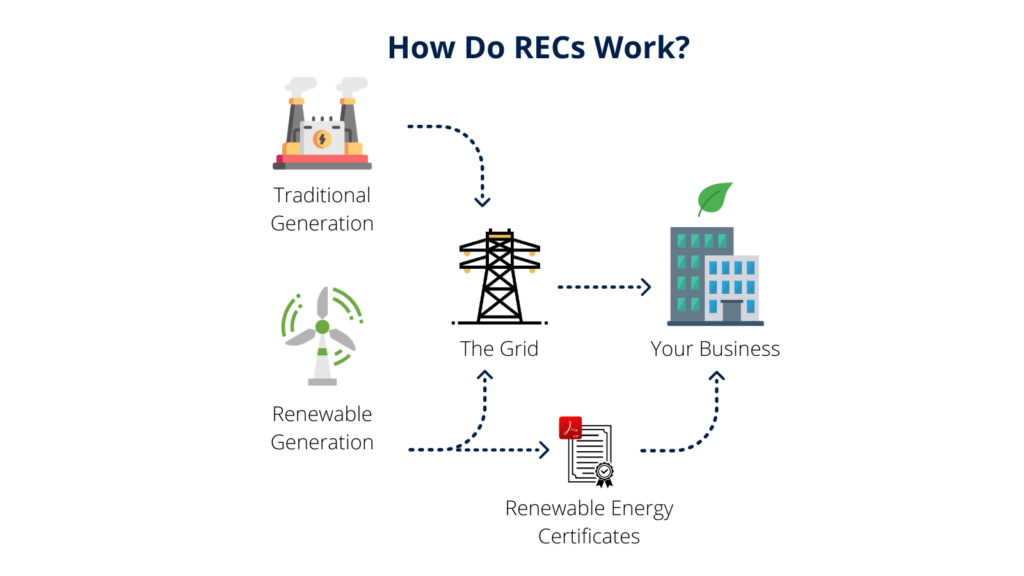< Back to Newsroom
Powering Up: Renewable Energy Certificates (RECs) – A Foundational Tool for Clean Energy
For organizations looking to reduce their carbon footprints, curbing electricity-related greenhouse gas emissions is a major piece of the puzzle. When adding renewables onsite or sourcing clean energy directly isn’t feasible, Renewable Energy Certificates (RECs) have provided a key tool for offsetting emissions from purchased electricity. In this post, we’ll break down what RECs are, how they work, and why they matter.

Jan 17 2025 | 7 min read
In our Powering Up blog series, experts from across the MN8 Energy team share insights to help you better understand clean energy procurement and fleet electrification and sustainability initiatives. In this post, we’ll break down what RECs are, how they work, and why they’re an essential tool for reducing emissions and advancing corporate sustainability strategies.
For organizations looking to reduce their carbon footprints, curbing electricity-related greenhouse gas emissions is a major piece of the puzzle. When adding renewables onsite or sourcing clean energy directly isn’t feasible, Renewable Energy Certificates (RECs) have provided a key tool for offsetting emissions from purchased electricity. In this post, we’ll break down what RECs are, how they work, and why they matter.
What is a Renewable Energy Certificate (REC)?
A Renewable Energy Certificate (REC) is like a receipt for clean energy. For every 1 megawatt-hour (MWh) of renewable electricity generated – whether from solar, wind, geothermal, biomass, or hydropower – one REC is created, and when it’s claimed by the owner, it’s “retired” to avoid double-counting Think of it as proof that renewable energy has been added to and used on the grid.
Once renewable electricity enters the grid, it mixes with electricity from all sources, including fossil fuels. This makes it impossible to track where any specific electron came from. A REC bridges this gap: it allows organizations to claim the environmental benefits of renewable energy, even though the electricity powering their operations can’t be directly traced.
According to the Environmental Protection Agency (EPA), RECs are the standard for demonstrating ownership of renewable energy generation. They’re especially vital for companies working to reduce their Scope 2 greenhouse gas (GHG) emissions, which are tied to purchased electricity.

Source: EPA Green Power Partnership
Why Renewable Energy Certificates (RECs) Matter
“The Renewable Energy Certificate (REC) plays a crucial role in promoting renewable energy development by acting as a tradable credit within both compliance markets, where states use them to meet Renewable Portfolio Standard targets, and voluntary markets, where corporations purchase them to demonstrate their commitment to sustainability and carbon reduction goals.” –Dr. Yinghuang Ji, Head of Structuring, Revenue and Commodities at MN8
At MN8 Energy, RECs are not just a tool for tracking renewable energy; they’re a cornerstone of our commitment to sustainability. By ensuring the environmental benefits of renewable energy generation are quantified and available to our partners, MN8 actively supports the growth of clean energy infrastructure while enabling organizations to meet their renewable energy and decarbonization targets.
Our projects generate RECs that help states meet Renewable Portfolio Standards (RPS), contributing to policy goals that drive renewable energy adoption. Additionally, MN8 provides RECs to corporate partners in voluntary markets, empowering them to claim the environmental benefits of renewable power and reduce their Scope 2 greenhouse gas emissions.
By leveraging RECs, MN8 plays a pivotal role in accelerating the transition to a cleaner, more sustainable energy grid, while providing measurable value to our partners and stakeholders.
How are RECs created and managed?
RECs are generated every time renewable energy is produced. Here’s how it works:
- A renewable energy facility – like a solar or wind farm – generates 1 MWh of power.
- Alongside electricity, a REC is created to represent the environmental benefits.
- Each REC includes key details like:
- The energy source (I.e.: solar, wind).
- Generation date.
- Facility information.
- A unique tracking ID to prevent double counting.

Who provides the RECs?
RECs are issued by “registries,” regional organizations that track renewable energy production and administer RECs. When a solar farm, wind farm, or other renewable energy facility produces electricity, a tracking system issues a REC to represent the environmental benefits of that energy. These tracking systems, like M-RETS (Midwest), PJM GATS (Mid-Atlantic), or WREGIS (Western U.S.), act like record-keepers. They verify the energy was produced, create the certificate, and track it until it is retired, to ensure each REC is unique and only used once.
Why do companies buy RECs?
- Cutting Scope 2 emissions: Matching electricity use with RECs lets companies reduce Scope 2 emissions associated with their electricity purchases.
- Boosting Renewable Energy Projects: Every REC purchased signals demand for clean energy, encouraging the development of new projects.
- Flexibility at Scale: RECs offer a scalable option for organizations to meet their sustainability goals without when other options for sourcing clean energy aren’t feasible.
How do RECs fit into an organization’s sustainability strategy?
While RECs are a key tool for decarbonization, they’re just one piece of the sustainability puzzle. Every company’s energy needs are unique, and so are their sustainability goals. RECs offer a flexible, scalable solution for reducing emissions and supporting renewable energy development. They’re especially valuable for:
- Meeting Sustainability Goals: RECs help organizations reduce Scope 2 emissions and can support claims of 100% renewable energy usage. If the RECs include more granular information on where or when they were produced, they can also support more advanced goals, like procuring 24/7 carbon-free energy (CFE) or reducing local grid emissions.
- Encouraging Clean Energy Development: By purchasing RECs, companies signal demand for renewable energy, driving the creation of new projects and supporting cleaner grids.
- Supporting Environmental Justice: In some cases, RECs can support investment in renewable energy projects in underserved communities, growing access to clean energy and promoting equity.
Why are RECs important to advancing clean energy?
RECs serve important purposes beyond environmental benefits—they represent growth and opportunity. Here’s why they’re critical:
- Revenue Generation: Each REC produced by renewables projects provides revenue, enabling further investments in renewable energy.
- Incentivizing Development: RECs add value to renewable projects and make their business cases stronger, supporting the development of additional clean energy facilities.
- Advancing Decarbonization: Continuing to grow the supply of renewable energy is central to curbing the emissions from our power sector overall, and RECs are a key tool in the transition to a sustainable future.
In future posts, we’ll delve into additional facets of clean energy sourcing and decarbonization that leading companies are pursuing, including electrifying transportation, how the market for clean energy continues to grow and shift, and share about PPAs centered on additionality, emissionality, emissions-first or 24/7 carbon-free energy approaches.
Looking to purchase RECs to support your sustainability strategy? Reach out to [email protected].

